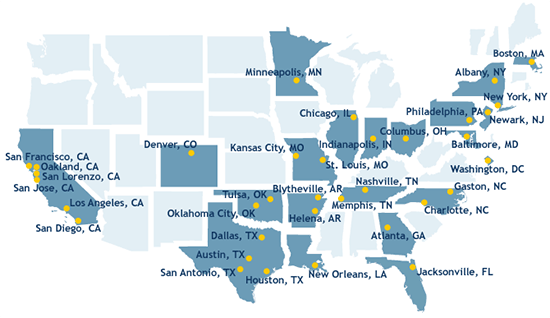Leading Palm Oil Producer Sues RSPO in Swiss Court


The Roundtable on Sustainable Palm Oil (RSPO) has not had an easy time over the past year, as many palm oil producers allegedly ran afoul of the RSPO’s standards — guidelines to which many of these companies agreed in the first place when they helped establish this organization.
Last year, the RSPO suspended dozens of members after many neglected to send an annual report on their business operations. Then an investigation into one of the world’s largest sustainable palm oil producers, IOI Group, accused the Malaysia-based company of causing the destruction of peatlands and forests in Indonesia. One of IOI’s most important customers, Unilever, severed ties with the company after the RSPO suspended the producer’s membership. Other companies followed Unilever's lead.
Now IOI is suing the RSPO in a Zurich, Switzerland, court.
According to an IOI news release, the company filed the lawsuit on two grounds. First, IOI alleges that the suspension was based upon standards covering operations within palm oil plantations — but the company claims those rules were used against its downstream processing units, which are held to a different set of RSPO standards. In addition, IOI complains that the RSPO’s decision should not apply to existing palm oil purchase and sales contracts to which the company had already agreed before the suspension. Meanwhile, IOI insists that it is still committed to membership within the organization and its sustainability principles.
But many environmental organizations are not buying into IOI’s rhetoric.
Greenpeace's United Kingdom chapter has been especially vocal on the problems related to the global palm oil supply chain, and the organization has investigated lands managed by IOI in Indonesia’s West Kalimantan region on the island of Borneo. Despite the RSPO’s rules that ban palm oil production on peatlands (which are a carbon sink and minimize fire risks in tropical rainforest regions), last month Greenpeace Indonesia investigators found continued drainage and development in such areas.
Mongabay, an advocacy group focused on both preserving the world’s forests and holding companies operating in such regions responsible for destructive business practices, has long made public allegations of land grabbing by IOI. The organization has also been vocal in its criticism of the RSPO, claiming that investigations into land grabbing take way too long to resolve. Mongabay’s complaints against IOI have been ongoing for years; their grievances include the company’s refusal to respect court decisions that returned some of its palm oil plantations to indigenous peoples who had long lived on that land.
Another NGO calling out IOI is Rainforest Action Network (RAN). Despite the company’s claim that its palm oil operations were “green” and “sustainable,” the nonprofit has accused IOI of non-compliance when it comes to RSPO standards. And at the same time, RAN activists expressed disappointment over past grievances, when the RSPO would grant IOI extensions, which allowed the company to continue selling palm oil even as one of the certifying board’s committees agreed it had breached RSPO guidelines. IOI has many subsidiaries that source, produce and sell palm oil across the world, and RAN has investigated many of them, including IOI Loders Croklaan, one of the largest exporters of palm oil to the U.S.
When it comes to the ill effects of palm oil, much of the focus centers around Southeast Asia. Indonesia and Malaysia are the two largest global producers of this commodity, which is used in many food products and consumer packaged goods. But the RSPO points out that Latin America has emerged as a major sustainable palm oil producing region. Almost 20 percent of RSPO-certified palm oil comes from countries such as Colombia, Ecuador, Guatemala, Honduras, Costa Rica and Peru. But that does not mean headaches similar to those caused by IOI will go away. Accusations of land grabbing have festered in Colombia and surrounding countries as far back as the 1960s.
In the meantime, IOI is standing its ground, determined to fight the RSPO suspension while the company insists it has a “zero-burning” policy and engages in sustainable agriculture practices. But until the photographs of fires and wide swaths of scorched earth stop circulating, do not expect environmental groups to give this company a free pass anytime soon.
Image credit: CIFOR/Flickr
Climate Action Lessons the Developing World Can Borrow from the U.S.


By Paritosh (Pari) Kasotia
On April 22, some 171 countries commemorated Earth Day by signing the Paris Agreement. At the opening ceremony of the United Nations climate talks in Paris, U.N. Secretary-General Ban Ki-moon said: “We are in a race against time. I urge all countries to join the agreement at the national level.”
The commitments to address climate change go back to the 2009 Copenhagen Accord which established the $100 billion Green Climate Fund to help developing countries address and build resiliency to climate change. The United States committed $3 billion in 2014 in addition to commitments from other developed countries. While financial assistance is urgently needed, it is just one side of the coin. The other side – enhancing the soft infrastructure, the know-how and the culture is equally significant to assist developing countries in the transition from high-carbon to low-carbon economies.
The United States makes a great case study for this and has demonstrated over the last years that underscoring the non-financial side can produce significant and measurable results as well.
According to the U.S. Energy Information Administration (EIA), U.S. energy consumption has slowed down. The agency predicts that this consumption will not return to the growth levels seen during the second half of the 20th century. A key point to note here is that household energy consumption is expected to remain relatively flat. Improvements in appliance efficiencies and consumer awareness, hand-in-hand, are driving this trend.
The U.S. is also witnessing “decoupling” of economic growth and energy consumption. According to the U.S. Department of Energy, the U.S. will continue to see an increase in economic growth and population, but its energy consumption will remain steady. Interesting to note, this trend in U.S. energy consumption is driven by advances in energy efficiency, renewable energy and natural gas.
So, what are the key lessons developing countries can derive from the U.S.? The trends mentioned above occurred in the absence of any national policies or mandates. The Clean Power Plan came into existence much later. Rather, it was the state policies and federal/local incentives, along with consumer preferences and changing market dynamics, that helped drive the market. Here are some key takeaways.
- Strengthen local soft infrastructure: Most developing countries employ a top-down development model where policies and agendas are established at the highest level of government and are passed down to the state and municipality level. Bringing impactful change will necessitate all levels of government to serve as change-agents, which requires the presence of operative soft infrastructure to deliver services to consumers. The U.S. Department of Energy’s SunShot Initiative Soft Costs program is an example of a program working to build effective soft infrastructure. The Soft Costs program works with local governments and other stakeholders to reduce market barriers that inflate the costs of solar deployment and hinder market growth. The Solar Foundation, through funding from the U.S. Department of Energy, recently launched the SolSmart program, a national designation program designed to recognize communities that have taken measurable steps to minimize local barriers to solar energy deployment. Building soft infrastructure improves service delivery and enables consumers to take action.
Convening delegates from developing countries for workshops and exchange of best practices, focused on building local capacity, can expedite the adoption and implementation of climate-change programs and policies.
- Effectively utilize the private sector as champions: Apart from being famous for technology, clothing and food, companies such as Intel, Microsoft, Kohl’s, Whole Foods, Google and Apple are renowned for their commitment and action on clean energy. They are the trailblazers of the clean-energy movement. These companies top the ranks for utilizing the greenest and the cleanest energy options. Microsoft is one of the biggest consumers of renewable energy sources, and 80 percent of its annual electricity comes from clean energy. Going a step further, Microsoft also implemented an internal carbon tax program to limit its own carbon emissions. The clothing retailer Kohl’s, through a combination of solar credits and on-site installed solar projects, gets 105 percent of its electricity from clean-energy sources.
Besides sending a clear signal to the market about their desire to reduce their carbon footprints, these companies play a pivotal role in influencing policymakers, competitors and consumers in making sound energy choices. Developing countries must emulate this culture of action, promotion and influence. A significant credit in creating this culture of influence goes to the U.S. media, both mainstream and grassroots, for bringing visibility and highlighting these success stories.
The local media, as well as civil society, in developing countries should be equipped with tools and resources to amplify local success stories emerging from their private sector. This will bring broad awareness and influence how climate change and clean energy issues are perceived and acted upon.
- Increase consumer understanding of energy efficiency and renewable energy: The U.S. clean-energy movement is an offshoot of the environmental and self-reliance movement. A multitude of environmental organizations in the U.S. -- at the national, state and local levels -- have incorporated clean energy and energy efficiency in their organizational agendas. By one count, there are over 25,500 environmental organizations in the U.S. If even 25 percent of these organizations promote energy efficiency and clean energy, it amounts to one organization per 50,000 individuals. And this is just nonprofits. Including other organizations such as lobbying firms, schools and higher-education institutions, and environmental centers, you have a civil-society structure that saturates the market for increasing consumer awareness. India, in comparison, shows 69 nonprofit environmental organizations, by one count, that may or may not touch on clean energy and energy efficiency.
Investing funds to build this volunteer-based, action-oriented capacity -- whether it’s at schools and universities, religious institutions, housing associations or even at work centers -- will significantly increase awareness among the populations to demand clean energy and subsequently reduce emissions, especially in high-carbon economies.
The U.S. is far from perfect. It still has a lot of room to improve and grow into a society that consumes energy responsibly and sustainably. The above takeaways are examples of what the U.S. is doing right. As world leaders carve out projects via the Green Climate Fund, they will be remiss to ignore the value-add of soft infrastructure and the civil-society capacity in assisting countries' transition to a low-carbon economy.
Image credit: Pixabay
Paritosh (Pari) Kasotia is the Deputy Director of The Solar Foundation (TSF) based in Washington DC with a mission to increase understanding of solar energy through strategic research and education that transforms markets. Prior to her role at TSF, Pari founded and led Unfolding Energy and also led the State of Iowa’s Energy Office by managing multi-million dollar projects to advance energy efficiency and renewable energy.
Should We Take Millennials' 'Rejection' of Capitalism Seriously?


Millennials keep making headlines. After the media was trying to figure out why so many of them support (or even love!) Bernie Sanders, a new survey brought up somewhat more surprising news: The majority of millennials reject capitalism.
Yes, you’ve heard it right. A Harvard University survey, which polled young adults between ages 18 and 29, found that “51 percent of respondents do not support capitalism. Just 42 percent said they support it.” In addition, 33 percent said they supported socialism.
Analysts scratched their heads trying to make some sense of it. Max Ehrenfreund of the Washington Post wrote the results could indicate “that today's youngest voters are more focused on the flaws of free markets.” Zach Lustbader, a senior at Harvard involved in conducting the poll suggested that capitalism could mean different things to different people, and for millennials it is mostly associated with the financial crisis. Lisa Manley of Cone Communications framed it in terms of the need to move toward a more responsible capitalism: “There is a movement already that’s called ‘conscious capitalism,’” she said. “I think it begins to address the concerns that underly the Harvard survey results.” Finally, Abe Sauer of brandchannel noted that “whether they know it or not, millennials has been drivers of some of the most capitalistic phenomenon in the last century.”
So, can we actually learn something from the survey findings? Should we take them seriously?
To answer these questions, let’s first look at the near past. In 2011 a Pew Research Center survey found out that 46 percent of 18- to 29-year-old Americans had positive views of capitalism, while 47 percent had negative views. At the same time, this age group was more positive than negative about socialism (49 percent versus 43 percent, respectively). In 2010, a similar survey from Pew Research Center revealed that more people in this age group viewed both capitalism (48 percent versus 43 percent) and socialism (49 percent versus 43 percent) negatively.
These results indicate that there is nothing new about millennials’ dissatisfaction with capitalism, at least since the 2008 financial crisis. It also may indicate that millennials indeed associate capitalism mostly with the great recession and therefore have negative views about it. But we need to compare the post-financial crisis with pre-financial crisis data to know if this the case or not. Still, given that the financial crisis is considered to have been particularly influential on millennials, my guess is that this assumption may have merit.
And still, it looks like we are surprised to hear that so many American millennials don’t view capitalism positively, just like we are surprised that so many of them support a presidential candidate who identifies as a democratic socialist instead of a mainstream candidate (although they will settle eventually for the latter). But we’re also surprised about the success of Donald Trump, aren’t we? We seem to be surprised in general these days -- refusing to accept the fact that perhaps a growing number of people in the U.S. are not satisfied with ‘business as usual’ and wonder if there are better alternatives.
With millennials, though, the surprise might have something to do with the fact there are a growing number of data points suggesting that American millennials, the 92 million people born between 1980-2000, are back on track: Their spending in general is expected to grow in 15 percent in the next five years, not to mention data suggesting that millennials are going back to buying cars and homes in the suburbs. Add millennials’ tendency “to own multiple devices such as smartphones, tablets and gaming systems," and it's easy to understand why it looks like they're reintegrating into the capitalist machine, not resisting it.
This also has a lot to do with framing. Look everywhere around you, and you see that millennials are framed not as a generation rejecting capitalism, but as a generation of consumers with unique traits -- or, in other words: Just like any other generation, they have their own identity, but they are still part of the capitalistic system.
Here are some few examples for this type of framing:
- “Millennials are much like other shoppers — just a whole lot more connected." (Accenture)
- “We found a generation engaged in consuming and influencing, one that embraces business and government and believes that such institutions can bring about global change, one that is generally optimistic, and one that has often unexpected attitudes and behaviors.” (BCG)
- “The most exciting part of the millennial story to me is that where up to this point we had really seen companies take a reactive approach to this consumer, who they didn’t really understand but their behaviors were changing – it was more about playing defense. Today, companies are taking proactive approach to investing in areas where they think this consumer is going and that’s going to have profound effect on the consumer economy going forward.” (Goldman Sachs)
Another example of the importance of framing when it comes to millennials is their participation in the sharing economy as service providers: 51 percent of the Americans who offered services in the sharing economy are millennials, which is much higher than their share in the labor force that is estimated in 34 percent. Is this a manifestation of flexibility and greater choice as some suggest, or a reflection of a market mechanism allowing millennials to cope with downward mobility, while making them poorer at the same time, as others claim?
Which narrative is the right one? Is it a story of a spoiled, entitled generation that is “all about instant gratification” as presented in this SNL sketch? Is it a story about a generation that had an economic setback, but eventually is not that different from other generations? Or maybe this is a story about young people who were uniquely punished by the recession and feel betrayed by a system that was supposed to provide them with better prospects than driving for Uber.
To some extent, it’s probably all of the above. But of course one of these narratives will become more dominant eventually. It’s hard to predict which one, as predictability is almost impossible in a VUCA world (think of the Donald Trump example). However, if I still need to place my bets, I would go with the last option. Capitalism is just a choice we make, and like any other choice that doesn’t work that well, you shouldn’t be surprised (or amazed) to see it replaced by another choice that could provide millennials better prospects than the unpredictable gig economy or working for corporate America.
Bernie Sanders may be losing in his bid for the presidency, but that doesn’t mean American capitalism is winning -- at least not for some millennials.
Image credit: Pixabay
Mars, Inc. U.K. Operations to Run on 100 Percent Renewables


You might know Mars, Inc. for its Snickers bars and M&M candies. But for several years the company has also proved to be an interesting case study on corporate responsibility and clean-energy investment.
On one front, the global food giant has responded to changing consumer preferences, promising to eliminate artificial colors from its food products while becoming more transparent about food labeling. A supporter of the COP21 climate talks in Paris last year, Mars put its money where its mouth is when the company announced it would invest in the equivalent amount of wind power needed to electrify its entire U.S. operations.
Today, Mars says it has made similar moves in the United Kingdom’s wind power sector so that its operations within Great Britain, which employ at least 4,000 people, are carbon-neutral.
In a press release issued today, Mars announced it has entered into a partnership with Eneco Wind U.K., a subsidiary of the Dutch utility Eneco BV, to buy electricity from the Moy Wind Farm for at least the next 10 years. Completed last month near the Scottish Highlands city of Inverness, this 60-megawatt wind farm will generate a sufficient amount of wind power needed for the 12 Mars sites located across the U.K. That is enough electricity to power 34,000 average-sized U.K. homes, or as the company likes to say, it's enough power to make 4.2 million Mars bars, 80 billion pieces of Wrigley Extra gum or 3 billion servings of Uncle Ben’s Rice.
Fun facts aside, the Mars-Eneco agreement is a shot in the arm for those who advocate for the continued deployment of renewables in the U.K. Since the Conservatives won a clear majority in the country’s parliamentary elections last year, London has turned away from the more aggressive clean-energy policies developed after the Tories entered into a coalition government with the Liberal Democrats following the 2010 election.
The consultancy EY, for example, ranked the U.K. at an all-time low for renewable investment this year, after ranking the country on top of its list for years during the mid-2000s. As energy journalist Fiona Harvey outlined this week in the Guardian, the U.K. tumbled to 13th on these rankings after the current government eliminated many clean power financial incentives while many members of parliament (MPs) have expressed outright hostility toward sustainable development and energy initiatives. In fact, a new regulation has even banned scientists, including those working climate change, from speaking out against government policy if they received state funds for their research.
Furthermore, Ed Davey, a former Liberal Democrat MP who was the previous government’s secretary of state for energy and climate change but was defeated by a Tory in last year’s election, said the outlook for renewables could become even worse if U.K. citizens vote yes on the “Brexit” referendum scheduled for June 23 -- which will determine whether or not Britain remains in the European Union.
Critics of the U.K.’s past commitments on renewables, however, pointed out that energy subsidies were often diverted to foreign companies, such as Abu Dhabi's Masdar, an investor in two offshore wind farms: the three-year-old London Array and Dudgeon, the latter of which is currently under construction. The counter argument, however, is that U.K. consumers benefit from lower electricity prices due to the foreign investment in the country’s renewables sector.
Mars is a privately-held company, and the $33 billion firm did not release the financial terms of its partnership with Eneco. Nevertheless, this deal should send a strong signal that despite declining government incentives made available to scale renewables throughout the U.K., technologies such as wind power are becoming even more cost-efficient and competitive with that of fossil fuels — even as oil prices continue to hover around $40 to $45 a barrel.
Image credit: Eneco
Solar Power and the Future of Air Travel


By Holly Whitman
You've probably heard all the hype surrounding self-driving cars. But have you heard about the latest in technology related to air travel?
No, it's unlikely that airplanes will fly themselves anytime soon. But air travel is seeing its own innovations -- and these advances involve the sole use of solar energy to produce flight.
Around the world on solar power
In 2002, Swiss pilots Bertrand Piccard and Andre Borschberg launched the Solar Impulse project, an initiative to make air travel more environmentally sustainable by eliminating the need for traditional fuel. The goal of Solar Impulse is to influence the future of air travel -- and, in doing so, help save the planet -- by relying entirely on power from the sun.
The current adventure, which has been ongoing since the initial takeoff from Abu Dhabi, United Arab Emirates, in March 2015, is the completion of a round-the-world flight with a solar-powered aircraft called Solar Impulse 2. The airplane has already set impressive world records, including its status as the first aircraft to traverse an ocean (the Pacific) on solar energy, as it successfully flew to Hawaii from Nagoya, Japan.
The round-the-world adventure is far from over. By the end of its travels in 2016, Solar Impulse 2 is expected to cover approximately 35,000 kilometers -- which means about 500 flight hours, between two pilots, in an unheated and unpressurized cockpit. The lightweight aircraft was not designed to deliver passengers, but rather to deliver the message that society can make giant strides toward a more sustainable future through the use of clean energy.
Borschberg touches down in Phoenix
Where is Solar Impulse 2 now, you might be wondering? The answer is that the 2.3-ton, solar-powered aircraft just landed at Phoenix Goodyear Airport on the evening of May 3, and its much-anticipated arrival was met with plenty of applause from locals.
The airplane, piloted by Borschberg during this leg of the journey, left from Mountain View, California, earlier that morning, resulting in a 16-hour trip. Still, Borschberg said, this was a short flight compared to some of the adventure's other legs. The record-breaking trip from Japan to Hawaii took five days and five nights to complete. Both Borschberg and Piccard, who was responsible for piloting the plane from Hawaii to Silicon Valley, say they rely on techniques such as yoga, self-hypnosis and meditation to stay alert while in the air.
While Solar Impulse 2's landing at Goodyear Airport was not open to the public, the hangar held a public viewing of the aircraft on Friday, May 6, and Saturday, May 7. The plane is expected to depart from Phoenix this week and make stops in a few more U.S. cities before touching down in New York, from which point it will make its way across the Atlantic Ocean to Europe or Africa.
Solar Impulse 2 boasts a 72-meter wingspan, which is as wide as that of a Boeing 747, despite being the weight of a car. It's powered by 17,248 solar cells and four propellers, which run on stored energy at night. The aircraft is capable of reaching altitudes of up to 28,000 feet.
What this means for the future of air travel
Solar Impulse 2's journey has proven that a single-seat airplane is capable of traveling long distances on sun power alone. But how likely are we to see multi-passenger, commercial aircrafts adopt a solar approach to fuel?
The fact is that clean, renewable energy has gained popularity in a variety of contexts for the last several years. For example, in 2006, the Arizona Corporation Commission enacted the Renewable Energy Standard and Tariff (REST), which stated that electric utility companies must produce at least 15 percent of their power from renewable sources by the year 2025. The use of solar power specifically has increased dramatically in homes since 2011. Solar energy sources, including heaters, water pumps and roofing panels, are in high demand and have dropped in cost over time.
But when it comes to air travel, the issue becomes a bit more complicated. The idea of solar-powered airplanes is interesting in theory -- after all, the aviation industry accounts for 3 percent of society's global warming footprint and is facing pressure to reduce its carbon dioxide emissions because of the deleterious effects on climate change.
The problem is this: Despite the success of the Solar Impulse project, it's unlikely that solar technology can be applied to a passenger aircraft like a Boeing 747. Compared to the lightweight Solar Impulse 2, a Boeing 747 has a take-off weight of at least 350 tons, despite its relatively equal wingspan. It would be extremely difficult, if not impossible, for engineers to add enough solar panels to an airplane this heavy using existing technology.
Solar Impulse 2 is also extremely limited in speed, reaching a maximum of only 43 miles per hour (slower than a car or train). By contrast, passenger aircrafts often fly up to 570 miles per hour -- and consumers aren't likely to sacrifice travel speed in exchange for greener energy sources.
One more issue is that there's a limit to how far a solar-powered plane can fly without stopping to recharge. That's why Solar Impulse 2 has touched down so many times during its sojourn across the world. Since pilots can't pull from a constant source of sunlight, particularly at night, Solar Impulse 2 must often rely on its Lithium-ion batteries, which means that the aircraft can only fly 1,000 kilometers at a time.
When asked at a press conference whether commercial airlines would ever be fueled by solar energy, Piccard said it would be "crazy to answer yes and stupid to answer no." He continued: "Today we couldn't have a solar-powered plane with 200 passengers. Maybe one day."
So, don't expect your vacations or business trips to be solar-powered any time soon. Nevertheless, the Solar Impulse initiative, with its high level of publicity and innovative nature, is still effecting immediate change by raising awareness about the importance of sustainable living -- even if that means you're just a little more diligent about recycling this year.
Image © Solar Impulse, used with permission
Holly Whitman is a writer and journalist tackling global issues from environmental problems to human rights. You can find her on Twitter at @hollykwhitman or her blog, Only Slightly Biased.
Motivating models for 21st century employee engagement


By Adam Woodhall - Employee engagement is a buzzword that has been around for a long time, but what does it actually mean, and what are the benefits to organisations?
There are many ways an organisation can engage its employees. This article explores both the theory and practice, especially in relation to the social side of sustainability. I’ll highlight two best practice examples from this vast galaxy of programs, initiatives, and missions, one from either side of the Atlantic, one a niche NGO and the other a high profile brand.
Whilst there are hundreds of definitions of this field, a particularly well- rounded one comes from the Chartered Institute of Personnel and Development (CIPD). Engagement is: “being positively present during the performance of work by willingly contributing intellectual effort, experiencing positive emotions and meaningful connections to other”. They make a useful distinction between emotional engagement (driven by a desire to do more for an organisation) and transactional engagement (drive to earn a living and progress).
An influential book in this field is Drive. The author Daniel H Pink looks at the science of motivation, and concludes that extrinsic 'carrot and stick' drivers are very 20th century. He encourages organisations to focus on three intrinsic motivators, or emotional engagement as defined by the CIPD, that can be summarised as autonomy, mastery and purpose. Employee engagement connected to sustainability is, of course, particularly useful for boosting purpose as a motivator, as is demonstrated in the two case studies following.
Engagement Benefits
Whole books have been written on the benefits of engagement. To summarise, they are; employee satisfaction, productivity, retention and recruitment, innovation and profitability
There is some very robust data to back this up. For example, Gallup found companies with highly engaged workforces outperformed their peers by 147% in earnings per share, and had:
· 41% fewer quality defects
· 48% fewer safety incidents
· 37% less absenteeism
In the competition for talent, it is key to offer a competitive salary and ensure people can grow in their role, but there is clear evidence that pay performance and job satisfaction are not highly correlated. A meta-analysis of the literature in this area found only a 2% overlap between these two factors.
There is now also increasing evidence that sustainability can help employee engagement. The 2013 book, "Talent, Transformation and the Triple Bottom Line", found that initiatives created growth in overall employee engagement. Interestingly, a 'halo' effect was generated as a strong programme raised engagement rates also for those who did not take part. Furthermore, a global survey by Bain found that nearly two-thirds of respondents said sustainable business is extremely important to them.
There is still progress to make, though. In the Ceres report "Gaining Ground", they found that whilst more companies were utilising sustainability engagement, only 6% of companies were in what they termed 'Tier 1' for systematically embedding it.
Taproot – inspiring intentional thinking
For many, when we hear "pro-bono", we think of law firms donating staff time. In fact, this term can refer to the donation of any service, and the US- based Taproot Foundation is an exemplar in this broader field.
I recently had a conversation with Lindsay Firestone Gruber, their MD of Advisory Services, and was inspired by the work they are delivering to both provide social and commercial value and engage employees.
"We work with our clients, both the corporates and non-profits who benefit from the skills share, to build the biggest impact possible. Taproot helps source and vet the organisations to ensure they are really ready. It is very important to us to evaluate and better understand the impact we have on the NGO's and the communities they serve.”
“There is a recognition that experiential learning opportunities can be much more powerful than classroom-based simulated scenarios. The employees of our corporate clients get to use their existing expertise in an unusual setting with a new challenge and different people. This stretches them in a way that really helps to take their engagement to a new level, and is often explicitly incorporated into talent development programmes. Whether the pro-bono project is one day for exec development or three months for high potentials, this all enables the employees to think intentionally."
Taproot's programmes therefore not only support people's intrinsic desire for purpose, but also help them in their mastery of their personal skills sets, two of Pink’s drivers.
Warburtons – engaging communities and employees
The conversation with Michael McDermott, Corporate Sustainability Manager at Warburtons Bakers, was similarly stimulating. As a business, they started out in 1886 with a corner shop, and are now the second largest grocery brand in the UK after Coca-Cola, employing 4500 people.
Still owned by the Warburtons, it is clear the ethos of the family pervades the organisation.
Michael enthused, "People are always looking at ways for business to gain value beyond salary and live the values to match our strapline, 'From Our Family to Yours'."
Michael highlighted many areas where they are making excellent progress in sustainability, which could easily fill a whole article in itself. An area, which seems particularly relevant to employee engagement is their community investment strategy, 'Family Matters'. This is not just about passively giving money; it is a pro-active engagement with their communities, which has involvement of staff at its core. From their 'Community Service Volunteers' to how they involve employees in choosing their national charity partner, the company is always looking at ways of engaging their people.
Michael observed that everybody in the business, including the Warburtons family, were delighted when they were included recently in the Top 25 Best Companies to work for. In the area of 'Giving Something Back' they were rated particularly highly. It is possible that the company wouldn't have got into this prestigious list without the excellent work they have done in this area. It is evident, therefore, that this success is creating a virtuous loop which will keep building benefits both for staff, society and the business.
I hope this brief, hyper-speed journey through the galaxy of employee engagement has given a glimpse into how organisations can benefit from implementing programs, and that the couple of quick stops made for a quick overview inspires employers and employees alike to become active in participating in this vital area of working life.
Transparency, Accountability and Better Working Conditions


Transparency is a big buzzword these days, particularly in textiles, where there is a real momentum to transform an industry where unsafe working conditions are still far too common. But what does it really meant to be transparent, and how does that translate into real changes in factories around the world?
The movement to improve worker safety took center stage after the tragic Rana Plaza factory collapse in Bangladesh that killed 1,137 workers. Most of the companies that were connected to the disaster were caught by surprise, unaware that such dangerous practices were taking place along their supply chains. Part of this was willful ignorance, but part of it was also the complete lack of a structure to monitor, implement and check-up on standards around the world.
“Traditional supply chains are no longer business-as-usual for brands that design, develop and source products,” fashion startup maven Laura McCann Ramsey told Apparel Magazine. “Corporate initiatives around supply chain transparency have become just as essential as a brand’s logo, mission statement and value proposition.”
Today, all across the developing world are initiatives aimed at increasing transparency. Yet, to this day, worker abuses and unsafe conditions are just as prevalent as they were a few years ago. Yes, there has been progress, but it has not come fast enough, nor has it positively impacted as many workers as is necessary.
“Most of the solutions that have been employed have been factory-by-factory solutions,” Jill Tucker, head of supply chain innovation and transformation with the C&A Foundation, told TriplePundit. “This usually impacts a few lucky workers – who happen to be in those factories that produce for reputation-sensitive brands.”
The C&A Foundation is pushing for industry-wide -- and country-wide -- standards for several reasons. Firstly, such standards would level the playing field, so that those companies putting more money into better factories and higher worker pay are not being undercut by competitors, but also so more workers are impacted. Transparency at a broader level is key for this.
Also key is sharing information, so that an entire industry is held to the same standards and there is no “leakage.” One initiative aimed at improving cooperation and data sharing is the U.K.-based Supplier Ethical Data Exchange (Sedex), which allows members to share data on a wide variety of metrics, including labor standards.
Technology can play a key role, too. We can, in real time, track suppliers, look into practices in their factories and even communicate directly with workers. For example, RFID tags, which are becoming smaller and cheaper, could allow products to be tracked down to single items. Dole, for example, now labels each banana it sells with a farm number, allowing consumers to see exactly where their delicious fruit comes from.
Getting data is one thing. Ensuring that it can be translated, understood and leveraged for real change is another.
“The problem is very long, dense reports that make it hard to compare one brand to another,” Tucker told us.”We're trying to make a database that is simpler and [easier] to compare across companies.”
One example of an initiative that is using data to promote transparency is the Better Factories Cambodia project, started in 2001 with support from the International Labor Organization (ILO). Transparency proved to be a key tool in driving incremental, measurable changes in the country's large, and growing, garment industry.
Lastly, but not to be forgotten, is ensuring that workers are part of any transparency initiative. That means not only ensuring their voices, and concerns, are part of any information gathering, but also that they have access to information to make informed decisions and, if necessary, demand their rights.
“Workers at this point are often not consulted and don't have channels to speak to management,” Tucker said. “Transparency provides data that is important to both workers and management.”
One thing is clear: Just being transparent is not enough. The next step is figuring out how transparency can empower real changes that lead to the ethical, sustainable, accountable supply chains that consumers are demanding. Instead of responding to disasters, such as the Rana Plaza collapse or the Foxconn iPhone factory suicides, companies could be proactive -- using data, technology and shared knowledge to prevent abuses and disasters from happening. Now that would be real change.
Editor's note: An earlier version of this post reported that Sedex is headquartered in Sweden. The post has been updated to reflect the organization's correct base in the U.K.
Photo Credit: Honest Reporting via Flickr and Unsplash
Austin Kicks Uber and Lyft to the Curb


What started out as one segment of the sharing economy has turned into billion-dollar valuations for ridesharing companies such as Uber and Lyft. But in recent years, concerns over drivers’ compensation have galvanized the labor movement as workers pushed back against the growing “gig economy.” And worries over passenger safety led to more cities’ attempts to regulate the likes of Uber and Lyft.
Austin, Texas, for example, wanted to require the fingerprinting of drivers, ban the pick-up and drop-off of passengers in certain street lanes, and have cars identified with company logos.
Uber and Lyft wanted none of that, and poured resources into a proposition that would have overturned regulations passed by Austin’s city council late last year. Together, Uber and Lyft were reported to have spent over $8 million convincing Austin’s 885,000 residents to vote “yes” on Proposition 1, while opponents of the measure could only raise $125,000.
But last Saturday, Austin’s voters rejected Prop 1 in a landslide, by 56 percent to 44 percent. In what was described as the most expensive campaign in Austin’s history, Uber and Lyft ended up spending about $200 on each “yes” vote.
As a result, both Uber and Lyft have said they will suspend operations in Austin for now. One ridesharing service, GetMe, said it will abide by Austin’s rules and plans to recruit new drivers in the Texas state capital.
The results, according to some local Austin leaders, are a victory for cities that say they welcome ridesharing companies, but on their terms, not on the demands of the likes of Uber and Lyft.
The Austin vote is a loss for Uber, which had long been accustomed to getting its way across the U.S. in cities such as Portland, Oregon. In an effort to bend cities’ will to allow Uber into new markets on its terms, the company has hired the likes of Barack Obama’s 2008 campaign strategist David Plouffe to lobby city councils and mayors across the U.S. The results have been spectacular for Uber, which is valued well over $60 billion, though some critics have suggested its valuation has reached its peak (Lyft, in contrast, is estimated to be valued at a figure one-tenth of Uber's).
Uber and Lyft certainly did their best to muscle voters into voting for Prop 1. The companies’ campaign site touted what they called the obvious reasons to let these companies self-regulate: a decrease in drunk driving accidents; affordable transportation that also “created” 10,000 jobs; and what the companies described as a reputation for safety that should appeal to all demographics.
But both companies stand accused of crossing the line between political hardball and dirty tricks. For example, Uber was accused of sending pro-Prop 1 text messages to users of its service, which led to a complaint with the Federal Communications Commission (FCC) and a lawsuit filed by a local activist. Both companies were also accused of offering free rides to polling stations so that locals could vote. Of course, on that matter, attorneys can parse over these companies’ terms and conditions of use endlessly — after all, Uber says it has the right to send messages “including information about products, services, promotions, news, and events of Uber and other companies.” Nevertheless, many voters felt such tactics and unsolicited text messages were in bad form.
But complaints about deceptive campaign practices are moot, anyway, as the 17 percent of Travis County voters who bothered to show up on Saturday were largely turned off by the amount of money Uber and Lyft threw at them in order to get their way.
In this case, money didn’t buy love, happiness or even a “yes” vote. Austin’s vote was less about transportation policy than a rejection of aggressive voting and marketing practices which made it clear that Uber and Lyft were not thinking about Austin’s commuters, but rather about conducting business on their terms without local citizens’ input.
Image credit: Mark Stevens/Flickr
Charter Schools: The Next Nationwide Scandal


As public school districts across the U.S. increasingly struggle with diminishing funds and a less-than-stellar reputation for quality education, charter schools have become a more popular option for parents -- especially those in poorer urban areas where traditional private schools are not an affordable option. Charter school organizations, while generally structured as nonprofits, said they could do more with fewer resources and improve students’ academic performance.
But while they seek public funds, the evidence suggests that some of these school operators are less than transparent about how they want to spend these funds, while others have balked at disclosing how students within their schools are performing in the classroom.
One such charter school operator is KIPP, which manages 183 charter schools enrolling 70,000 students from coast to coast. According to the Center for Media and Democracy, in recent years KIPP informed the Department of Education (DOE) that some information about its revenues and classroom performance is “proprietary,” even though the company has applied for millions in grants paid for by federal taxpayers. In fact, one grant application contained redacted information related to the amount of money KIPP received from private foundations.
Meanwhile, financial statements submitted to the DOE reveal that, while receiving over $61 million in private grants in 2013, KIPP spent:
- Over $400,000 on advertising and almost $5 million on travel expenses, including $1.2 million at Walt Disney World.
- Almost $14 million on compensation, including over $1.2 million on nine executives, plus another $2 million on retirement packages.
- $1.2 million to an analytics consultant in an attempt to rebuff any DOE concerns over academic performance and drop-out rates.
A 2011 university study also found that KIPP schools’ performance was not necessarily better than their competing schools in public education districts, and in fact, on the metrics were sometimes even worse. Many schools were found to have a higher attrition rate. And that one leading KIPP selling point, the retention of African American male students, was often a struggle — 40 percent of African American boys from the sixth to eighth grades left KIPP schools.
Other investigations found similar problems with other charter school systems across the U.S. In New Orleans, where public schools transformed into virtually an all-charter system after Hurricane Katrina, the city’s experiment has brought at best dubious results when it comes to attrition, graduation rates and the number of school suspensions. As the emphasis over the past decade focused more closely on student testing, “difficult to teach” kids have fallen through the cracks and critics say too many students are simply abandoned by the revamped school system.
And in Ohio, Politico reported that the Buckeye State’s struggles with charter schools could have damaged Gov. John Kasich’s political prospects if he had miraculously become the Republican presidential nominee. While applying for federal charter school grants, the state’s charter school director reportedly neglected to include failing grades in key charter schools’ performance analyses. The state received $71 million in federal funds. Some state leaders questioned the value of the awards given charter schools’ declining reputation in the state. The number of poorly performing schools increased from nine to 57 in an amended application. Incidentally, David Hansen, Ohio’s charter schools chief, is married to Kasich’s campaign manager and chief of staff.
Rather than address the core problems that have affected public schools, often tasked with educating the country’s poorest students, politicians for a generation have beaten the drum of privatization -- which enriched a few entrepreneurs while doing little for America’s most vulnerable youth.
Undercounting students, manipulating statistics and fudging the books have become an endemic problem. Meanwhile, companies like KIPP, which have received millions in federal, state and local grants, while maintaining best practices, such as this gem revealed in a review of a book by the author Jim Horn:
“Because of cultural differences, black students are accustomed to being screamed at … because that’s how their parents speak to them.”
The bottom is that if these sham companies do not have to play by the same rules as other organizations seeking public funds, what incentivizes their culture to treat students with dignity and respect?
Image credit: SupportingEducation.org
It’s Time to Hold Pharmaceuticals Responsible for the Opioid Epidemic


According to the Centers for Disease Control and Prevention (CDC), more U.S. citizens died from drug overdoses in 2014 than any year since the Atlanta-based government agency first began collecting such data. Approximately 78 Americans die from an opioid overdose each day. Of the estimated half a million Americans who died from a drug overdose between 2000 and 2014, 6 in 10 overdosed on opioids.
The disturbing fact is that while the CDC estimates the number of opioid prescriptions have quadrupled since 1999, there has been no overall change in the amount of pain reported by Americans. At the same time, deaths from prescription opioids —such as hydrocodone, methadone, oxymorphone and oxycodone — have also increased four-fold since 1999.
These drugs include Opana, Vicodin and OxyContin, the latter of which emerged two decades ago with the marketing claim that one dose would last as long as 12 hours, more than twice as long as similar prescription drugs on the market. And as a Los Angeles Times investigation concluded, many patients who were prescribed OxyContin found that the half-day relief from pain was not necessarily true. After combing through thousands of documents, including confidential records that belonged to OxyContin manufacturer Purdue Pharma, Times reporters Harriet Ryan, Lisa Girion and Scott Glover revealed:
- Purdue’s researchers knew even before OxyContin was available on the market that the 12-hour, pain-free claim was not necessarily true, and since the drug’s release in 1996, doctors, researchers and even the company’s sales reps sent similar complaints to the company.
- Realizing that, without this 12-hour advantage, OxyContin could not compete against other pain relief drugs on the market nor fetch its lucrative price, Purdue Pharma executives were determined to hold fast on this claim and urged even more aggressive marketing efforts and sales calls.
- Purdue instructed doctors to prescribe stronger doses of OxyContin, not more frequent ones, in the event patients complained that pain relief lasted less than 12 hours -- putting many patients at risk. And during the late 1990s, when more physicians began to prescribe OxyContin at shorter intervals, the company’s executives mobilized hundreds of sales reps to urge doctors to “refocus” on the 12-hour dose regimen.
Purdue Pharma, which refused to participate with the Times’ investigation, has vigorously defended OxyContin and rebutted the Times’ article point-by-point; Ryan then picked apart Purdue's arguments in the newspaper’s reply to the company.
A cauldron of events led to the the mass popularity of OxyContin and then the rapid increase in addiction. Before the mid-1990s, due to fears that they could become rapidly addictive, opioid medications were generally limited to treating symptoms for severe pain from terminal diseases such as cancer. At the same time, Purdue Pharma, owned by the wealthy Sackler family, needed a new product as its patent on MS Contin, another pain killer, was close to expiration. Upon the development of OxyContin, the company invested in a massive and aggressive marketing campaign, which even included music CDs and trips to posh resorts, in an effort to court doctors and convince them to prescribe the drug for conditions such as back pain.
It was around this time that the Food and Drug Administration (FDA) loosened regulations on direct-to-consumer advertising, and the prescription infomercial was born. While Purdue Pharma only focused its marketing on doctors, its persistent tactics -- such as sending videotapes touting OxyContin and patient “success stories” to 15,000 doctors across the U.S. -- helped sales of the drug soar. Never mind the fact that some of those stories were dubious, and forget about the Purdue Pharma executives paying $600 million in fines because of misleading statements to patients, doctors and regulators about OxyContin’s effectiveness and safety. Last year the Sackler family edged into Forbes’ list of the wealthiest American families, edging out the Busches, Mellons and Rockefellers.
But while the Sacklers have scored a massive financial windfall, its affects on families and communities, especially in rural America, has been devastating. Some have placed blame on doctors, with prosecutors focusing on shutting down the “pill mills” that have allowed many citizens to become addicted to painkillers. The CDC has suggested that insurers are paying far too much of these opioids’ costs, and that they should take measures to help reduce the number of prescriptions and, hence, risk of overdoses. Finally, the FDA -- bruised as it is clear its lax oversight contributed to this crisis -- is now considering a mandate that would require physicians to undergo risk training so that they become more judicious when prescribing opioids.
But the question is how to pay for such physician training, and then there are the patients. While drug rehab poses its own share of controversies and criticisms, it is clear society that has to find solutions, as we are all paying for this health scare one way or another.
Considering how pharmaceutical companies such as Purdue Pharma have reaped billions of dollars over the past 20 years thanks to their marketing campaigns, it is time for these firms to step up. They must acknowledge the overwhelming statistics that clearly link these drug manufacturers to this ongoing epidemic, and pay their fair share for education and treatment to help the U.S. overcome this public health disaster. The American Medical Association has called for a renewed ban on direct advertising by pharmaceutical companies; that money, along with funds used to "educate" doctors, could be diverted for other uses in an effort to heal society.
Image credit: Jennifer Durban